In Your Face
Makeup found to be contaminated with asbestos
The negative health effects of asbestos are well-known. Most people may associate asbestos contamination with the workplace or decades-old construction material, but alarmingly, recent media reports have found asbestos contamination in kids' makeup from popular stores. U.S. PIRG Education Fund (PIRG) decided to do its own asbestos testing at an accredited laboratory. PIRG tested over a dozen makeup products that contained talc from a variety of stores and brands, including children's and teen's products as well as adult's products, and found three products containing asbestos currently sold by Claire's retail company.
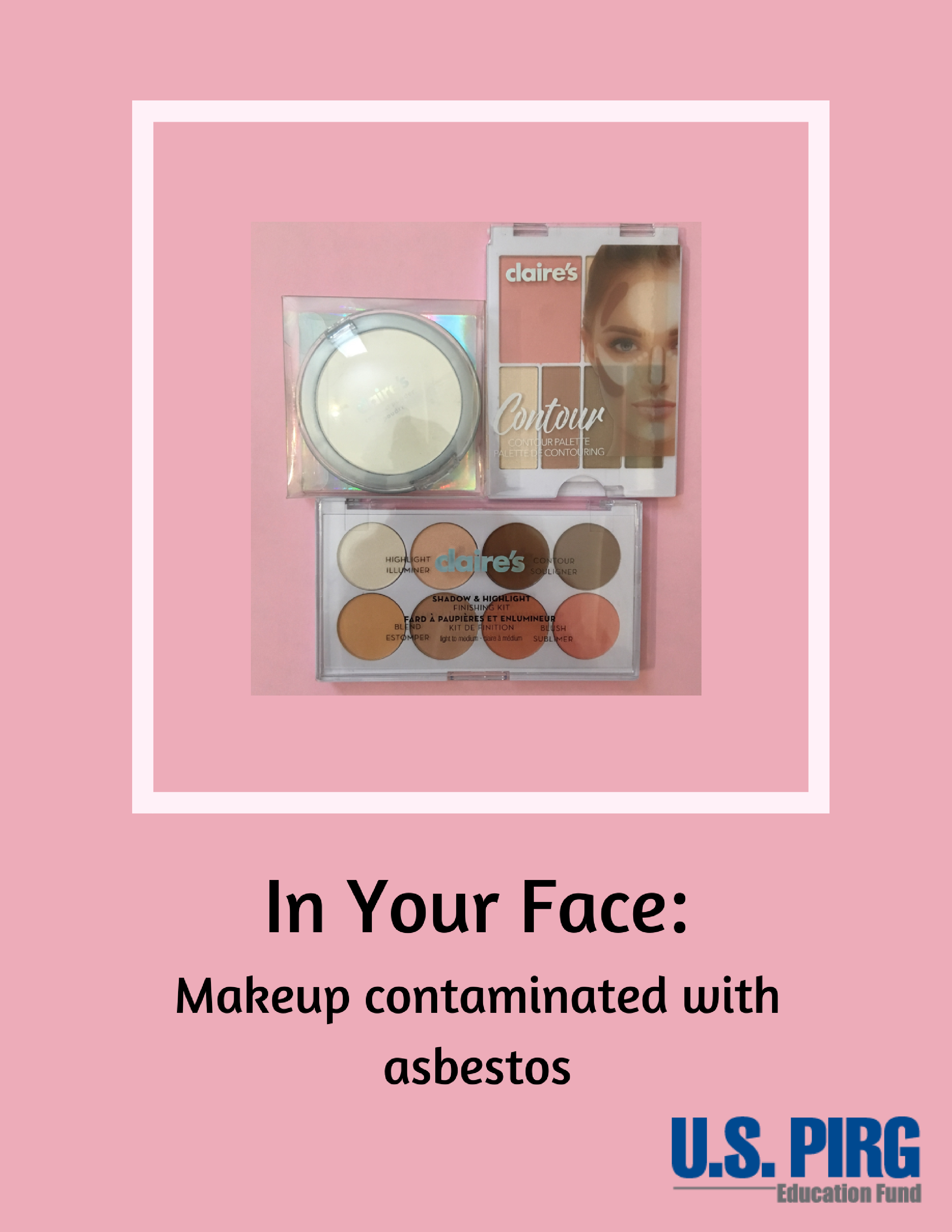
Negative Health Effects of Asbestos
Asbestos is not used commercially in makeup, but can be found as a contaminant in talc, a common ingredient in cosmetics. Sparkly, shimmery, and powdery makeup often contains talc as a major ingredient. Inhaling or ingesting any form of asbestos can lead to serious health conditions, including lung cancer and mesothelioma.
While asbestos may be considered a trace contaminant, there is a known risk that these mineral fibers can lead to several pulmonary diseases and lung cancers, such as malignant mesothelioma, when they are inhaled. Research has shown that asbestos fibers can disrupt DNA and lead to tissue damage. There are currently no effective means to predict which individuals exposed to asbestos will develop disease. Repeated topical exposure to asbestos may result in increased skin cancer risk over time. Short term increased risk of developing rashes would also be expected with use of asbestos containing products.
Asbestos Regulation
While the FDA considers it “unacceptable for cosmetic talc to be contaminated with asbestos” , there is currently no national agency charged with testing kids’ makeup for asbestos. While the FDA does occasionally test makeup for chemicals like lead and mercury, it does not do so regularly. Congress should take action to ensure that there’s no asbestos contamination in cosmetics, and FDA should conduct regular tests on cosmetics for asbestos.
Asbestos Found in Claire’s Makeup
After reading media reports purporting that some children’s makeup contains asbestos, we did our own testing. PIRG tested over a dozen makeup products from a variety of stores and found three products containing asbestos (tremolite) currently sold by Claire’s. The laboratory tests were done by STAT Analysis Corporation, an independent laboratory that is accredited for asbestos testing. The lab first conducted a PLM (polarized light microscopy) test for asbestos and found that three products tested positive for asbestos. The lab then performed the TEM (transmission electron microscopy) test to determine how many fibers of asbestos per gram each product contained. We then did a re-test of the TEM test to confirm the results, and those results are also listed in this report. FDA has also used both TEM and PLM methods in tests it conducted for asbestos in cosmetics.
Claire’s is a national retailer of cosmetics, jewelry, and novelties aimed at children, tweens, and young adults. We found three “shimmery” makeup products at Claire’s which contain asbestos.
Our report and test results come after Claire’s issued a recall of nine makeup products in December 2017 when those products tested positive for asbestos. Claire’s first announced the recall on Twitter and later released a statement on its website. Later, on January 14, 2018, the company released an updated statement that, according to its internal testing, it did not find any asbestos in its products. In January 2018, we purchased makeup items from Claire’s for testing. Despite Claire’s assurances that their products were uncontaminated, we found asbestos in three of the products that we purchased after Claire’s voluntarily pulled the original nine contaminated items off the shelf.
We are waiting to hear if Claire’s will pull these other three products off the shelves after we shared this information with the company, and we are waiting to hear if Claire’s is willing to do additional work to ensure that their consumers are safeguarded from asbestos contamination in their products. At this time, Claire’s denies that their products contain asbestos.
Laboratory results indicated that the following three Claire’s products contained asbestos:
1. Claire’s Contour Palette
Price: $9.99
Amount of asbestos found:
- PLM test results: Tremolite 1-2%
- TEM first round test results: 67,800 fibers of asbestos per gram of product (tremolite)
- TEM re-test results: 84,746 fibers of asbestos per gram of product (tremolite)
UPC: 8887-1140-1947
The top left pink blush was tested.
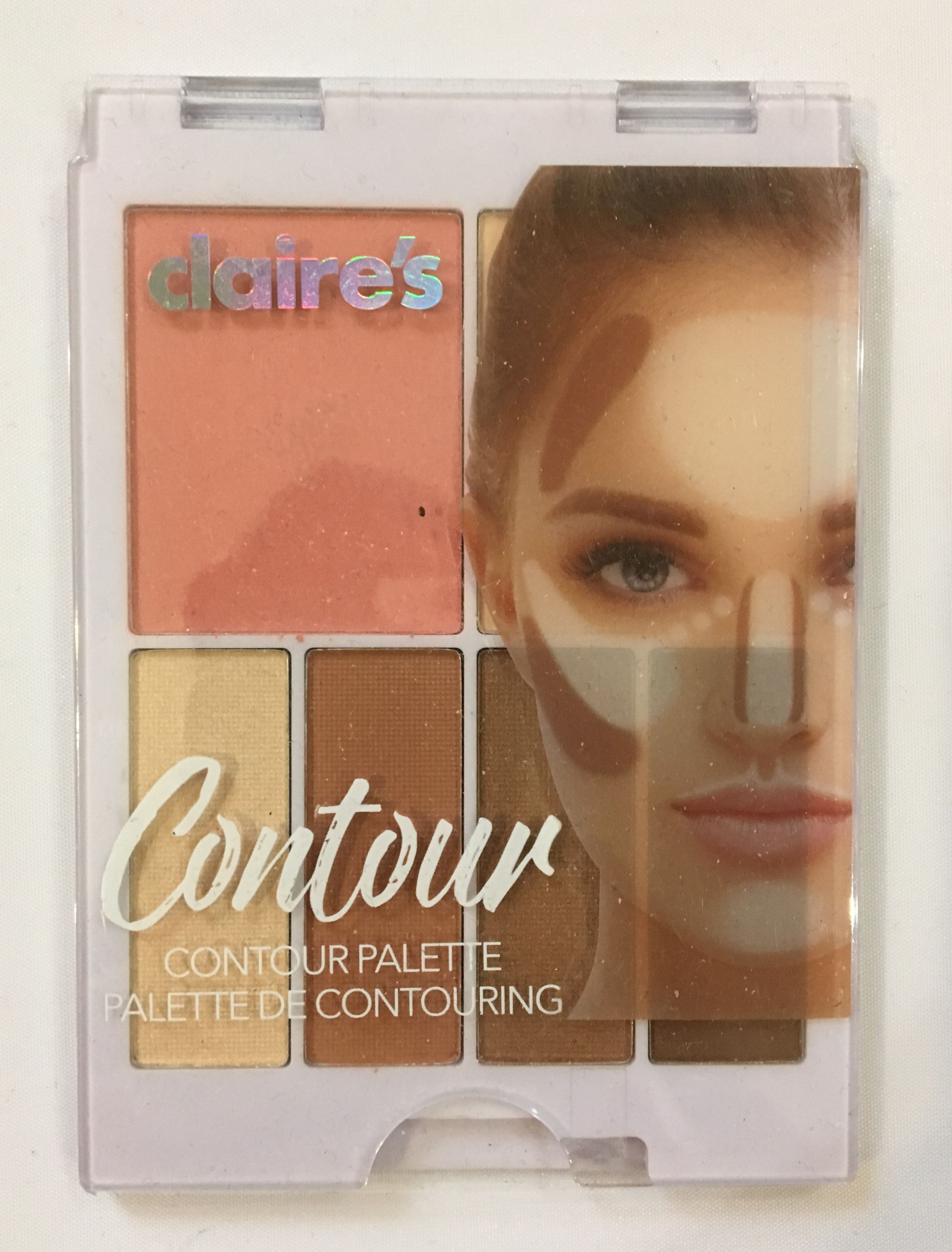
2. Claire’s Shadow and Highlight Finishing Kit
Price: $9.99
Amount of asbestos found:
- PLM test results: Tremolite 1-2%
- TEM first round test results: 38,000 fibers of asbestos per gram of product (tremolite)
- TEM re-test results: 61,538 fibers of asbestos per gram of product (tremolite)
UPC: 8887-1105-4358
The top right brown shadow was tested.
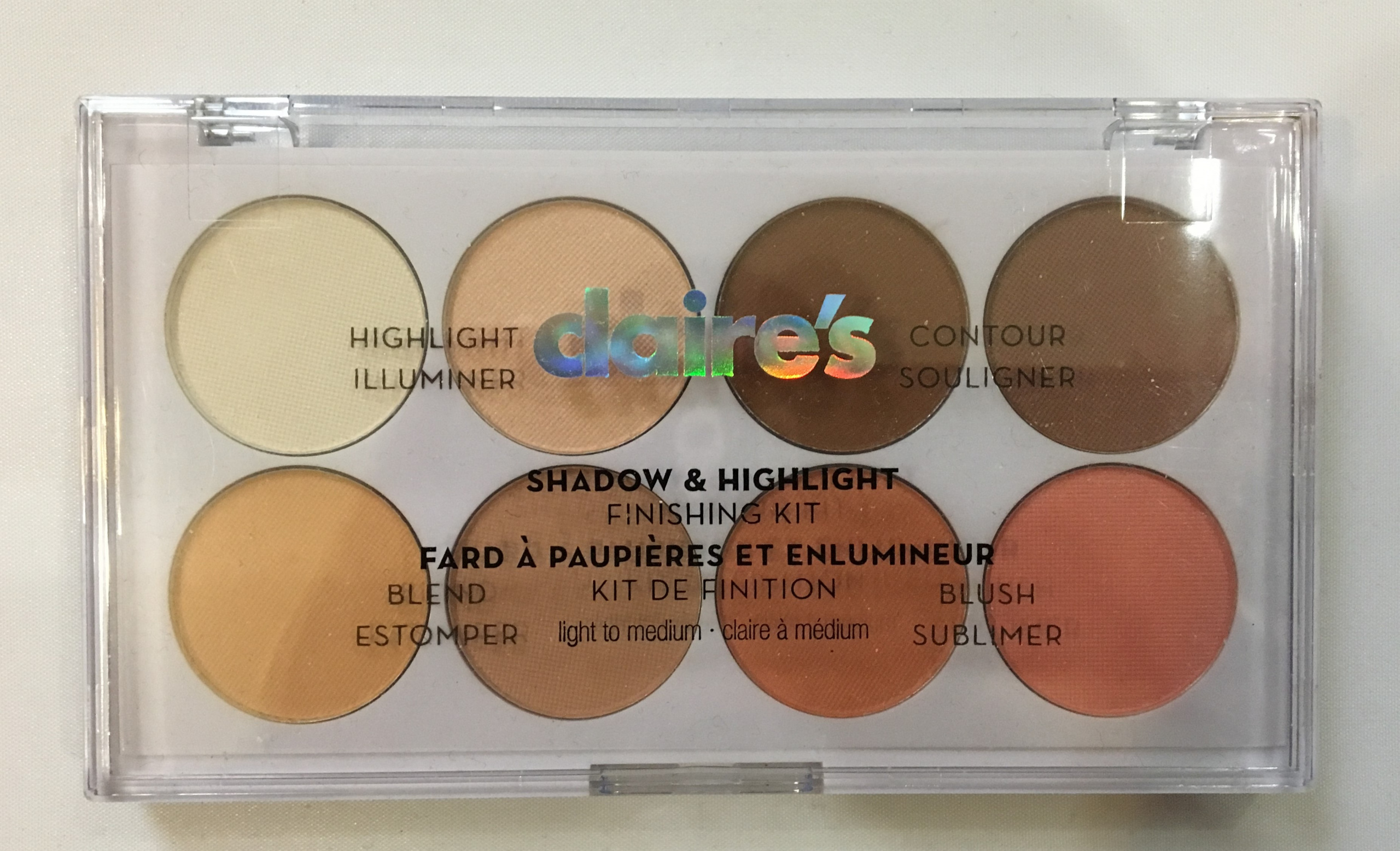
3. Claire’s Compact Powder (White)
Price: $5.50
Amount of asbestos found:
- PLM test results: Tremolite 1-2%
- TEM first round test results: 106,383 fibers of asbestos per gram of product (tremolite)
- TEM re-test results: 153,846 fibers of asbestos per gram of product (tremolite)
UPC: 8887-1183-9153
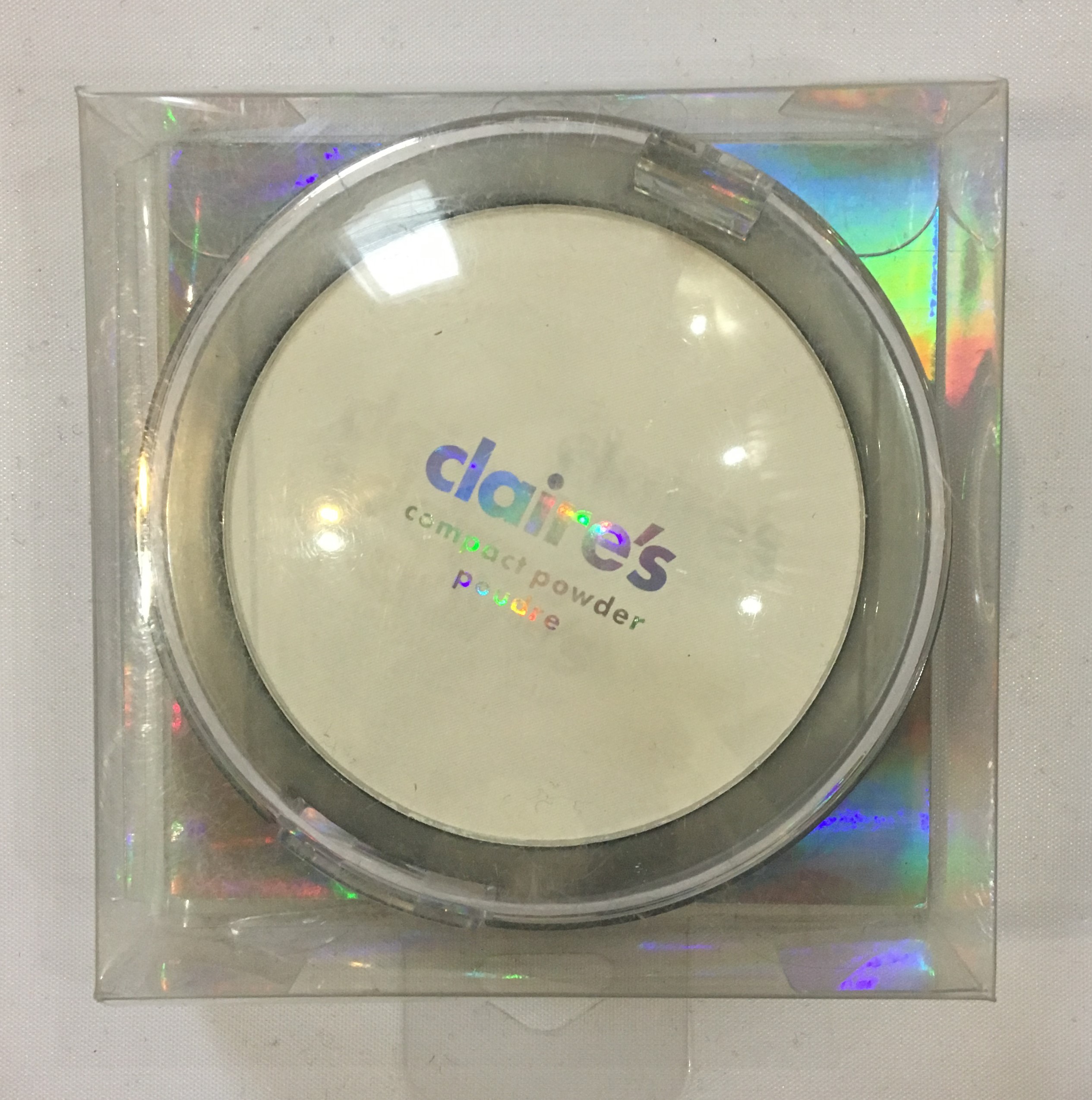
Methodology:
STAT Analysis Corporation analyzed the samples by Polarized Light Microscopy (PLM) and Transmission Electron Microscopy (TEM). FDA used PLM and TEM methods in the past when it commissioned tests for asbestos in cosmetics.
For asbestos testing in talc in makeup, FDA has used a lab accredited by the National Institute of Standards and Technology (NIST). The FDA used a lab on NIST’s list of labs that are accredited for both Bulk Asbestos Analysis and Airborne Asbestos Analysis for their cosmetics testing for asbestos (AMA Analytical Services), and we used another lab on the list, STAT Analysis Corporation.
Initial identification of asbestos fibers in the samples were made using polarized light microscopy according to morphology, sign of elongation, color of fiber, birefringence of the fibers, dispersion staining, and refractive indices. (Reference: Polarized Light Microscopy to determine type of asbestos and calibrated visual estimated concentration in bulk materials. Method: EPA/600/R-93/116).
STAT Analysis Corporation is accredited for EPA Method EPA 600/R-93/116 “Method for the Determination of Asbestos in Bulk Building Materials.” The lab followed this method for the PLM analysis of these samples, and the results are indicated as percentage of asbestos components.
Subsequent identification and quantitation of asbestos fibers in the samples were made by transmission electron microscopy according to morphology, aspect ratio, diffraction pattern, and elemental composition by energy dispersive x-ray analysis. STAT Analysis Corporation is accredited for EPA Method 40 CFR Part 763, Subpart E, Appendix A, “Interim Transmission Electron Microscopy Analytical Methods – Mandatory and Nonmandatory – and Mandatory section to Determine Completion of Response Actions.” The lab applied the analytical portion of this TEM method to the samples. However, this method is written for air samples, so the lab used the sample preparation method and counting rules given in “Kremer, T.; Millette, J.R., A Standard TEM Procedure for Identification and Quantitation of Asbestiform Minerals in Talc, Microscope (1990), 38.”
The results are given in fibers of asbestos per gram of product sample. Detection Limit: 20,000 fibers/gram.
STAT Analysis Corporation then re-tested the three product samples that originally tested positive for asbestos. They re-tested using the TEM method, using the original samples, to ensure accuracy of the testing results. The TEM re-test confirmed that the three samples contained asbestos fibers, and the re-test results are also included in this report.
1) PLM Results:
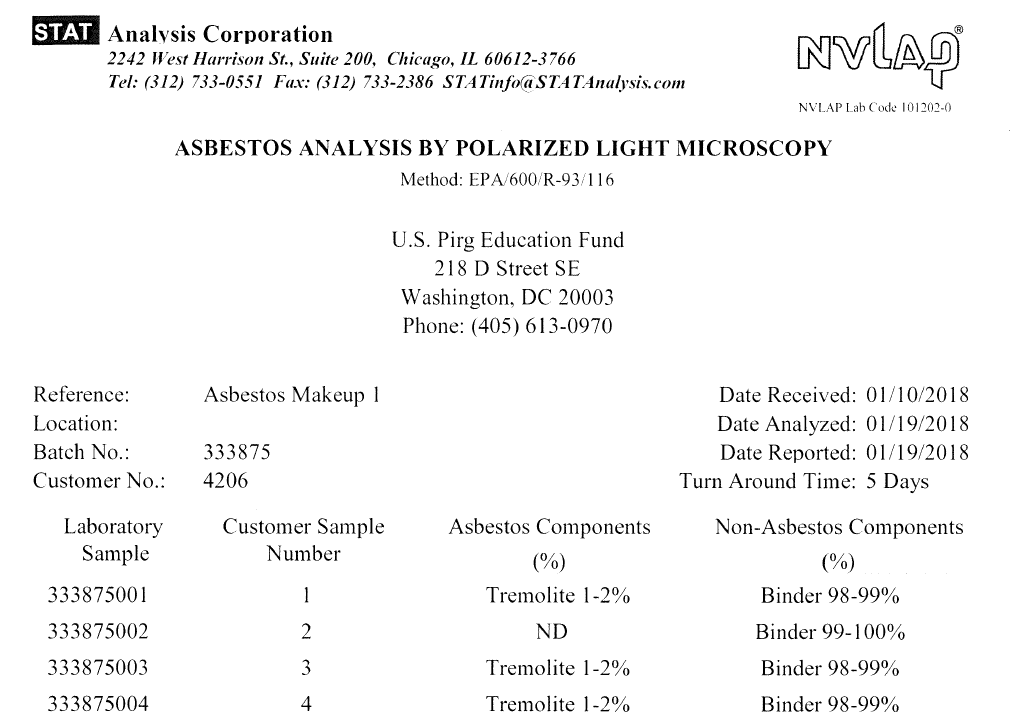
2) TEM Test #1
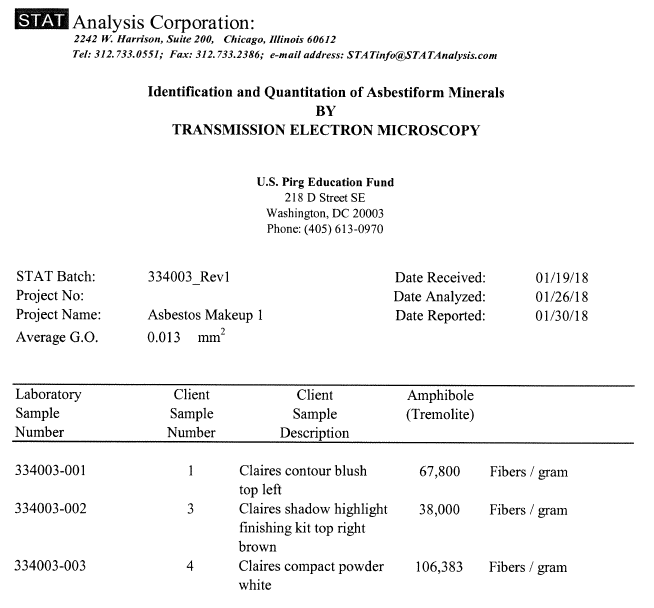
3) TEM Re-test
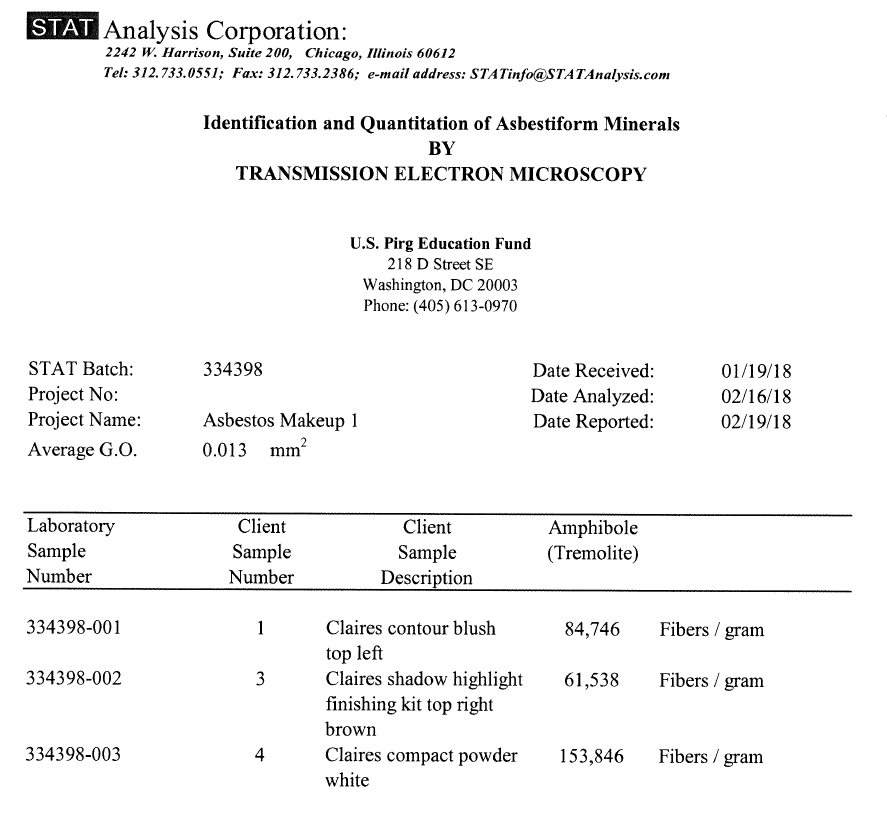
Recommendations:
For consumers:
● Consumers should stop using the three products listed above immediately.
● Parents should avoid buying children’s makeup products containing talc. Cosmetic talc can be contaminated with asbestos. FDA says that companies can prevent contamination of talc with asbestos, by selecting talc mining sites carefully and taking steps to purify the ore sufficiently. However, consumers have to contact companies directly to find out if their products’ talc is sourced safely.
● Join us in calling on policymakers to conduct thorough tests on makeup containing talc for asbestos contamination and remove contaminated products from store shelves.
For Claire’s:
● Immediately recall these three products and remove from store shelves.
● Issue a public statement about the recall due to asbestos contamination.
● Investigate how these makeup products came to contain such high levels of asbestos and make findings public.
● Ensure that other products sold or manufactured do not contain asbestos.
● Notify customers who purchased these products, where contact information is available, that they should stop using them due to asbestos contamination and offer a return for full refund.
For Policymakers and FDA:
● Policymakers should require makeup companies to test products for asbestos prior to selling them.
● FDA should conduct testing for other makeup products containing talc for asbestos.

